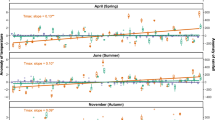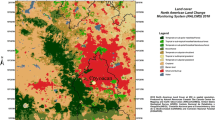Abstract
Malaga (Mediterranean coast) and Vigo (Atlantic coast) are representative of two bioclimatically different areas belonging to the Mediterranean and the Eurosiberian region, respectively. This contribution represents a study on recent trends in the principal meteorological parameters in these areas and their influence on the phenology of Urticaceae (nettle family) atmospheric pollen, one of the main causes of pollinosis in Spain. The study covers the period 1991–2006 for Malaga and 1995–2005 for Vigo, and compares the differences in climate and phenological behaviour observed at both localities. The sampling of atmospheric pollen was performed with Hirst volumetric pollen traps. The two localities present different tendencies as far as temperature is concerned: while the mean annual temperature in the Mediterranean region has increased by 0.06°C/year, the same parameter has decreased in the Atlantic area by 0.1°C/year. This tendency is even more pronounced as far as the minimum temperatures are concerned, especially during spring in Malaga and autumn in Vigo. On the other hand, wind speed has tended to increase, periods of calm have diminished and winds blowing off the sea have increased in both places. These changes in meteorological parameters have advanced the end of the pollen season in Malaga and delayed its start in Vigo. Total annual pollen counts have decreased in Vigo, while the number of pollen-free days has increased in both areas.
Similar content being viewed by others
References
Beggs PJ (2004) Impacts of climate change on aeroallergens: past and future. Clin Exp Allergy 34:1507–1513
Bond W, Davies G, Turner R (2007) The biology and non-chemical control of common nettle (Urtica dioica L.). http://www.gardenorganic.org.uk/organicweeds/downloads/urtica%20dioica.pdf. Cited 20 Oct 2007
Bortenschlager S, Bortenschlager I (2005) Altering airborne pollen concentrations due to the Global Warming. A comparative analysis of airborne pollen records from Innsbruck and Obergurgl (Austria) for the period 1980–2001. Grana 44:172–180
Carballeira A, Devesa C, Retuerto R, Santillan E, Ucieda E (1983) Bioclimatología de Galicia. Fud Barrié de la Maza, La Coruña
Clot B (2001) Airborne birch pollen in Neuchatel (Switzerland): onset, peak and daily patterns. Aerobiologia 17:25–29
Clot B (2003) Trends in airborne pollen: an overview of 21 years of data in Neuchâtel (Switzerland). Aerobiologia 19:227–234
D’Amato G, Spieksma FThM (1991) Allergenic pollen in Europe. Grana 30:67–70
D’Amato G, Ruffilli A, Sacerdoti G, Bonini S (1992) Parietaria pollinosis: a review. Allergy 47:443–449
Domínguez E (1992) The Spanish aerobiology network. Aerobiologia 8:45–46
Domínguez E, Galán C, Villamandos F, Infante F (1991) Handling and evaluation of the data from the aerobiological sampling. Monograf REA/EAN 1:1–18
Emberlin J (1994) The effects of patterns in climate and pollen abundance on allergy. Allergy 49:15–20
Emberlin J, Mullins J, Corden J, Millington W, Brooke M, Savage M, Jones S (1997) The trend to earlier birch pollen seasons in the UK: a biotic response to changes in weather conditions? Grana 36:29–33
Emberlin J, Dentandt M, Gehrig R, Jaeger S, Nolard N, Rantio-Lehtimäki A (2002) Responses in the start of Betula (Birch) pollen seasons to recent changes in spring temperatures across Europe. Int J Biometeorol 46:159–170
Frenguelli G, Tedeschini E, Veronesi F, Bricchi E (2002) Airborne pine (Pinus spp.) pollen in the atmosphere of Perugia (Central Italy): behaviour of pollination in the two last decades. Aerobiologia 18:223–228
Galán C, Cariñanos P, Alcázar P, Domínguez-Vilches E (2007) Spanish aerobiology network (REA): management and quality manual. Publications Services of the University of Córdoba, Cordoba.
García-Mozo H, Galán C, Jato V, Belmonte J, Díaz de la Guardia C, Fernández D, Gutiérrez M, Aira MJ, Roure J, Ruiz L, Trigo MM, Domínguez-Vilches E (2006) Quercus pollen season dynamics in the Iberian Peninsula: response to meteorological parameters and possible consequences of climate change. An Agric Environ Med 13:209–224
Gregory PH (1973) The microbiology of the atmosphere. Leonard Hill, Plymounth
Jackson M (2001) Allergy: the making of a modern plague. Clin Exp Allergy 31:1665–1671
Hirst JM (1952) An automatic volumetric spore trap. Ann Appl Biol 39:257–265
Ladeau SL, Clark JS (2006) Pollen production by Pinus taeda growing in elevated atmospheric CO2. Funct. Ecol 20:541–547
Martonne E (1964) Tratado de geografía física. Juventud, Barcelona
Newnham RM (1999) Monitoring biogeographical response to climate change: the potential role of aeropalynology. Aerobiologia 15:87–94
Nilsson S, Persson S (1981) Tree pollen spectra in the Stockholm region (Sweden), 1973–1980. Grana 20:179–182
Osborne CP, Chuine I, Viner D, Woodward FI (2000) Olive phenology as a sensitive indicator of future climatic warming in the Mediterranean. Plant Cell Environ 23:701–710
Paiva J (1993a) Parietaria. In: Castroviejo S et al. (eds) Flora Iberica vol. 3. Real Jardín Botánico C.S.I.C., Madrid, pp 268–270
Paiva J (1993b). Urtica. In: Castroviejo S et al. (eds) Flora Iberica vol. 3. Real Jardín Botánico C.S.I.C., Madrid, pp 263–268
Panayotopulu E, Tsaltakis K, Panayotopulos S (1991) Aerobiological monitoring in Greece (Athens-Thessaloniki) and screening of pollinosis. Grana 30:87–90
Pellizzaro G, Canu A, Arca B, Cesaraccio C, Vargiu A (2006) Use of pollen release as indicator of climatic change in an Mediterranean area. Geophys Res Abstr 8:06660
Rasmussen A (2002) The effects of climate change on the birch pollen season in Denmark. Aerobiologia 18:253–265
Rivas-Martínez S (1987) Memoria del mapa de series de vegetación de España. ICONA, Madrid
Rodríguez-Rajo FJ, Iglesias I, Jato V (2004a) Allergenic airborne pollen monitoring of Vigo (NW Spain) in 1995–2001. Grana 43:164–173
Rodríguez-Rajo FJ, Dopazo A, Jato V (2004b) Environmental factors affecting the start of pollen season and concentrations of airborne Alnus pollen in two localities of Galicia (NW Spain). Ann Agric Environ Med 11:35–44
Rogers CA, Wayne PM, Macklin EA, Muilenberg ML, Wagner CJ, Epstein PR, Bazzaz FA (2006) Interaction of the onset of spring and elevated atmospheric CO2 on ragweed (Ambrosia artemisiifolia L.) pollen production. Environ Health Perspect 114(6):865–869
Sahsamanoglou HS, Makrogiannis TJ (1992) Temperature trends over the Mediterranean region, 1950–88. Theor Appl Climatol 45(3):183–192
Spieksma FTM, Corden JM, Dentandt M, Millington WM, Nikkels H, Nolard N, Schoenmakers CHH, Wachter R, Weger LA, Willems R, Emberlin J (2003) Quantitative trends in annual totals of five common airborne pollen types (Betula, Quercus, Poaceae, Urtica, and Artemisia), at five pollen-monitoring stations in western Europe. Aerobiologia 19:171–184
Tedeschini E, Rodríguez-Rajo FJ, Caramiello R, Jato V, Frenguelli G (2006) The inflluence of climate changes in Platanus spp. pollination in Spain and Italy. Grana 45:222–229
Teranishi H, Kenda Y, Katoh T, Kasuya M, Oura E, Taira H (2000) Possible role of climate change in the pollen scatter of Japanese cedar Cryptomeria japonica in Japan. Clim Res 14:65–70
Thompson K, Grime JP, Mason G (1972) Seed germination in response to diurnal fluctuations of temperature. Nature 267 (5607):147–149
Torrecillas M, García González JJ, Palomeque MT, Muñoz C, Barceló JM, de la Fuente JL, Vega Chicote JM, Miranda A (1998) Prevalencia de sensibilizaciones en pacientes con polinosis de la provincia de Málaga. Rev Esp Alergol Inmunol Clín 13(2):122–125
Vidal C, Dopazo A, Aira MJ (2001) Parietaria pollinosis in an Atlantic area: clinical and palynological data. J Invest Allergol Clin Immunol 11:107–111
Wayne P, Foster S, Connolly J, Bazzaz F, Epstein P (2002) Production of allergenic pollen by ragweed (Ambrosia artemisiifolia L.) is increased in CO2-enriched atmospheres. Ann Allergy Asthma Immunol 8:279–282
Wüthrich B (1989) Epidemiology of allergic diseases: are they really in the increase? Int Arch Allergy Appl Immunol 90:3–10
Author information
Authors and Affiliations
Corresponding author
Rights and permissions
About this article
Cite this article
Recio, M., Rodríguez-Rajo, F.J., Jato, M.V. et al. The effect of recent climatic trends on Urticaceae pollination in two bioclimatically different areas in the Iberian Peninsula: Malaga and Vigo. Climatic Change 97, 215–228 (2009). https://doi.org/10.1007/s10584-009-9620-4
Received:
Accepted:
Published:
Issue Date:
DOI: https://doi.org/10.1007/s10584-009-9620-4




